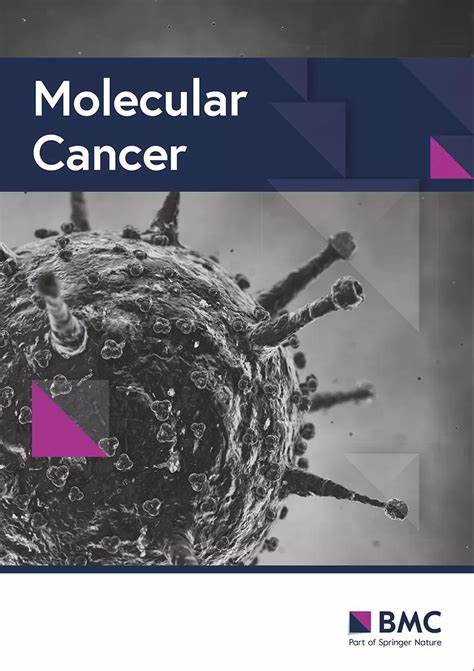NSUN2-mediated cytosine-5 methylation of FSP1 protects acute myeloid leukemia cells from ferroptosis
IF 33.9
1区 医学
Q1 BIOCHEMISTRY & MOLECULAR BIOLOGY
引用次数: 0
Abstract
RNA 5-methylcytosine (m5C), a prevalent epitranscriptomic modification that critically regulates gene expression and cellular homeostasis. While its roles in solid tumors have been increasingly recognized, the functional landscape of m5C in acute myeloid leukemia (AML) remains unexplored. Here, we identified NSUN2, the principal RNA m5C methyltransferase, as a key regulator of AML progression. NSUN2 was aberrantly upregulated in AML patient samples and correlated with poor prognosis. Functional studies demonstrated that NSUN2 promoted leukemic cell proliferation, enhanced tumor growth in xenograft models, and conferred resistance to ferroptosis—a regulated cell death process driven by lipid peroxidation. Mechanistically, NSUN2 catalyzed m⁵C deposition on the 3’UTR of FSP1 (ferroptosis suppressor protein 1) mRNA, facilitating its recognition and stabilization by the m5C reader protein YBX1. This NSUN2-YBX1-FSP1 axis protected AML cells from ferroptotic stress by suppressing lipid peroxidation and oxidative damage. Depletion of NSUN2 or FSP1 induced mitochondrial remodeling, which primed cells for ferroptosis. Reconstitution of wild-type NSUN2 or FSP1 rescued ferroptosis resistance, whereas catalytically inactive NSUN2 (C271A/C321A) or non-functional FSP1 mutants (G2A/E156A) failed to reverse this phenotype. Pharmacological inhibition of NSUN2 with MY-1B or targeting FSP1 with iFSP1 exhibited potent anti-leukemic effects, synergizing robustly with ferroptosis inducers, standard chemotherapy, and the BCL-2 inhibitor venetoclax. Our study unveils NSUN2 and FSP1 as prognostic biomarkers and therapeutic targets in AML. We highlight a novel epitranscriptomic mechanism linking RNA methylation to ferroptosis evasion, providing a dual-strategy approach to overcome AML treatment resistance.nsun2介导的FSP1胞嘧啶-5甲基化保护急性髓系白血病细胞免于铁凋亡
RNA 5-甲基胞嘧啶(m5C),一种普遍的表转录组修饰,对基因表达和细胞稳态具有关键的调节作用。虽然m5C在实体肿瘤中的作用已被越来越多地认识到,但其在急性髓性白血病(AML)中的功能景观仍未被探索。在这里,我们发现NSUN2,主要的RNA m5C甲基转移酶,是AML进展的关键调节因子。NSUN2在AML患者样本中异常上调,并与不良预后相关。功能研究表明,NSUN2促进白血病细胞增殖,增强异种移植物模型中的肿瘤生长,并赋予对铁中毒(由脂质过氧化驱动的受调节的细胞死亡过程)的抗性。机制上,NSUN2催化m - 5 - C沉积在FSP1 (ferroptosis suppressor protein 1) mRNA的3'UTR上,促进其被m5C读取器蛋白YBX1识别和稳定。该NSUN2-YBX1-FSP1轴通过抑制脂质过氧化和氧化损伤保护AML细胞免受铁致凋亡应激。NSUN2或FSP1的缺失诱导线粒体重塑,引发细胞铁下垂。野生型NSUN2或FSP1的重组恢复了铁下沉抗性,而催化失活的NSUN2 (C271A/C321A)或无功能的FSP1突变体(G2A/E156A)未能逆转这种表型。用MY-1B药物抑制NSUN2或用iFSP1靶向FSP1显示出强大的抗白血病作用,与铁下沉诱导剂、标准化疗和BCL-2抑制剂venetoclax具有强大的协同作用。我们的研究揭示了NSUN2和FSP1作为AML的预后生物标志物和治疗靶点。我们强调了一种新的表转录组学机制,将RNA甲基化与铁凋亡逃避联系起来,提供了一种双重策略方法来克服AML治疗耐药性。
本文章由计算机程序翻译,如有差异,请以英文原文为准。
求助全文
约1分钟内获得全文
求助全文
来源期刊

Molecular Cancer
医学-生化与分子生物学
CiteScore
54.90
自引率
2.70%
发文量
224
审稿时长
2 months
期刊介绍:
Molecular Cancer is a platform that encourages the exchange of ideas and discoveries in the field of cancer research, particularly focusing on the molecular aspects. Our goal is to facilitate discussions and provide insights into various areas of cancer and related biomedical science. We welcome articles from basic, translational, and clinical research that contribute to the advancement of understanding, prevention, diagnosis, and treatment of cancer.
The scope of topics covered in Molecular Cancer is diverse and inclusive. These include, but are not limited to, cell and tumor biology, angiogenesis, utilizing animal models, understanding metastasis, exploring cancer antigens and the immune response, investigating cellular signaling and molecular biology, examining epidemiology, genetic and molecular profiling of cancer, identifying molecular targets, studying cancer stem cells, exploring DNA damage and repair mechanisms, analyzing cell cycle regulation, investigating apoptosis, exploring molecular virology, and evaluating vaccine and antibody-based cancer therapies.
Molecular Cancer serves as an important platform for sharing exciting discoveries in cancer-related research. It offers an unparalleled opportunity to communicate information to both specialists and the general public. The online presence of Molecular Cancer enables immediate publication of accepted articles and facilitates the presentation of large datasets and supplementary information. This ensures that new research is efficiently and rapidly disseminated to the scientific community.
 求助内容:
求助内容: 应助结果提醒方式:
应助结果提醒方式:


